#also there’s no entry point into this graph
Text
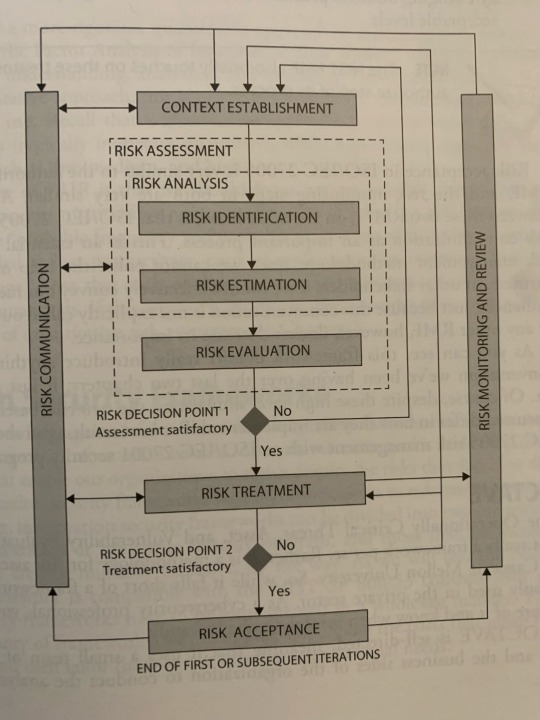
If you work in information security you too can study the world’s most boring, obvious diagrams
#oh I need to assess risks before I decide what to do about them???#amazing#don’t get me wrong#i got into this field because flowcharts and other node-graphs are my favorite way to express information#But I have been reading 30+ pages about how risk management is all about managing risk#also there’s no entry point into this graph#help im trapped in a risk management process and there’s no way out#the Minotaur’s labyrinth except it’s just a 9-5 desk job#wait that’s just called being alive#hmm#actually they should show this diagram during sex ed
8 notes
·
View notes
Text
youtube recommendations are very short-term sticky. If you deep-dive on a topic the algorithm logic will pin you as a certain kind of guy. But unfortunately it will then happily start showing you all the other stuff that that certain kind of guy might like. And most of the time, no. ewww. no.
So then you have to retrain it a little and head off to other mutually-exclusive topics so that you can keep the parts of the recommendations you like and stay far, far, far, away from the stuff you don't like. Freshen up the recommendations, shake out the dust and bugs
#I hope the yt algorithm people are enjoying the terrible wealth they receive for increasing 'engagement' even by a tenth of a percent#it would be kinda wild to browse the network graph of interests and see the emergent big-hop videos for various groups#by 'big-hop' I mean the videos the logic identifies as a small-time break-out hit - a vid you usually wouldn't find but do like#the ones that 'unlock' new areas of interest - leading to more subscriptions and views and more time on yt#and see what they've decided to do with vids and channels you watch once and don't really return to even though it maybe changed your life#stuff you definitely care a LOT about but won't lead to a steady stream of views#I once heard that big celebs can go to the ig office and see a more in-depth report about how people engage with their content#definitely a thing bc they have to have that rich analysis so they can make things more sticky#see the rankings of in-house categories - maybe stuff like “most likely to be immediately shared” and “share most widely”#or “longest streak of sharing” or “most rewatched” or “most likely to get people to leave yt for a while”#“high view count but also very dead-end”#“video with most scrubbing” “vid with most downloads” “vid watched over multiple days”#“entry points to watching a long series of videos”#“channels that people binge catch-up”#“vids most paused in a way that suggests following along with the instructions”#“vid with most local area permeation”#stepping-stone instructional videos where people move on to different topics after watching it#I should go to bed but I feel like I need a break from work - like a sabbatical - but not likely so i protest and stay up#my blog#youtube
0 notes
Text
Hermit Permits- or Hermitconomics101
I would just like to start off by saying I adore the concept. It's perfect. But also, I'm a massive nerd and I wanna talk about it.This is such a fascinating little economic model. Like, the usual hermitcraft economy is already so fascinating.
Warning-Long post! Also might Slightly skew your perspective of the Gimmick.
At first Glance, the Hermitcraft economy is the epitome of a Perfect Market economy -the basic selling/buying market you think of when thinking of markets-which has a few requirements
1. Homogenous products: gunpowder from Doc's shop is the same gunpowder from Tango's or Iskall or whoever sells it
2. No barriers to entry and exit: anyone can decide to sell. The technology's there. Any hermit can decide to make a farm or manually harvest something, set up shop and sell
3. Sellers are Price takers: If say, X and False are both selling copper ingots (for example), and X prices his higher than False (and they both keep their shops stocked), Hermits will buy from False. So X has to price the same (or lower but shhhh) than False.
4. Product Transparency: If you pay 1 diamond for a stack of iron blocks, you know you're getting 1 stack of iron. (usually) no shenanigans involved
And now the interesting point->
5. Many sellers- In a perfect competition market, the market is usually saturated with sellers, to the point that everyone needs to price the same, or at exactly the cost of production (or whatever needs to be to have the last seller joining the market to have economic profit of 0 but that's real hard to count in diamonds). Usually, this is done by having many firms coming in (free market remember) and undercutting each other until it's at the point where Supply is equal to Demand (yes, exactly the graph you're thinking of). In hermits' case, rarely is there more than one shop for an item unless there is an obnoxious amount of demand for it, and often, they'll buddy up in the same shop and split the profits and the work (I'm thinking of all the wood groups) for the highly in demand items. (More on that later).
So the sellers aren't usually competing with other hermits to sell resources- they're competing with the hermits' other way of procuring resources- The Endless Grind
Think about it- The rule of thumb for establishing the scope of a market (and its competition) is to ask yourself- where do I go if the shop becomes too expensive? In our real-life situation, we go to other shops- hermits just roll up their pixilated sleeves and get to work themselves. They are the alternative. (or Lag but stealing throws off all economic models so we're assuming it doesn't exist.)
A hermit shop, to have sales, needs to price its resources low enough that other hermits will see it as a better (cheaper) alternative than acquiring it themselves.
But Nemo, I hear you ask, isn't it always going to be cheaper to collect the material themselves? All the hermits already have all the tools/technology they'd need to get the resources they'd want, so shops wouldn't work.
But they do work, every season hermits "get rich" which implies there's something "wrong" with my model, which there is.
It's Time. That's the main currency in Hermitcraft.
Any hermits can decide to get any amount of resources with no real limit except Time. Sure, some hermits are more likely to build farms and have it done quicker than others, but all of them can decide to pick up a tool and just grind away (which they do, often). The point of the shops is to be convenient. You could spend 3 hours getting 15 stacks of oak wood, but you could also drop 30 diamonds at Ren's shop and get that done in less than a minute. Which, when you're a content creator on a tight deadline, already spending hours upon hours just building and editing and living outside of work, time is precious. So Time is the real trading currency on HC.
And so there comes a wrench in the plan as you have 2 "types" of goods- you have the Sellers' resources (that cost you diamonds but less time) and your own resources (which cost you Time but fewer diamonds)
Which invalidates point 3. Price Takers- There are 2 very different prices, which you are willing to pay at different times to different degrees. Somedays, they grind somedays they pay.
And thus, there goes the perfect competition model-
~~And in comes Monopolistic competition.
Now, listen to me, this is crucial ish- this is not the same as a Monopoly.
Monopolies imply there is 1 seller. 1. there is 1 way of acquiring the good (at this point in time) (everything is taken as if time is held constant). YouTube has a monopoly on hermitcraft videos (kind of). You can't watch Hermitcraft videos anywhere else, as the hermits don't upload their videos on other websites. If YouTube started charging 10000$ per video watched, you probably wouldn't watch hermit videos anymore. That's a monopoly.
Monopolistic competition is when a few firms sell slightly different products. Think Pepsi and Coca-Cola. They're functionally the same thing (don't @/me for this), but they both still work as companies, because people tend to prefer one over the other.
And thus our model. A monopolistic competitive market.
The real competition was not store vs store (unless for the bit), it was Sellers vs the Grind.
(There are also sunk cost fallacies exhibited, when hermits make their own farms for materials they know they'll need a lot of, which then reduces the time spent, especially with AFK'ing, thus the active time spent being reduced but server time still fluctuating but that can be hermitconomics 102 lmao)
But Back to this season-
With the introduction of Hermit Permits (which, is such a fun term, I wouldn't be surprised if they came up with that first before the concept) they are forcing there to be a single official seller. But hermits are still able to collect their own resources and make their own farms. So the market stays the same.
Which is probably not what you were expecting was it. All this fanfare but theoretically, the model doesn't change. It might change the point at which a hermits decides it's better to grind it out instead of spending diamonds, but not the theory.
But here's the second hole in this theory.
One of the first assumptions one makes about any market model is that everyone involved wants to maximize profits. (which irl, is making the most money).
But the same was as the real currency is Time, the real Profit for Hermits is Content (and engagement, and a whole bunch of parasocial scales to do with audience retention but I'm an economic major, not a sociology or business student damn it, we'll stick with Content) .
Theoretically, nothing changes in the economic model, but the result changes. The potential to change things up is massive, simply because they at least superficially changed something. Rebranding something, in a way that shakes up previously established norms- That's what they're getting out of it. Forcing people to do content about things they normally wouldn't even touch, which inspires viewers to be invested, so see our favourite blorbos overcome the challenge. It's a narrative device.
(If anything, I'd expect this to actually "promote the economy" as hermits would be motivated to stock up their shops, thus making more farms/farm building episodes, or the competition occurring from additional permits being circulated.)
So yeah. Hermitconomics 101- The not-so-perfect competition. Sorry If I burst some bubbles, I just think it's fascinating.
Thanks for reading to the bottom!
TL:DR :This is gonna be so fun, and the hermit economy makes economists everywhere cry
#hermitcraft#hermitcraft season 10#hermitcraft s10#hermitcraft s10 spoilers#hermitblr#hermitconomics#killing the bit#I'm way too excited#hyperfixation goes brrrr#hermit permits#hc s10 spoilers#hc10#hc s10
87 notes
·
View notes
Text
What was the HP fandom on AO3 writing in 2022?
some stats diving, ship- and femslash-focused.
default filters used for everything unless indicated otherwise: language: english, no crossovers. only on AO3 (obviously)

hmm someday i'll do a yearly breakdown maybe.
for reference, there were ~324,676 total works in the HP tag updated in 2022 and before, so the top ship Drarry makes up 16% of HP works.

ships in this list but not the former: jegulus, dorlene, and regulus & sirius.
ships in the former list but not this one: snarry, sevmione, tomarry.

harry the character is tagged in 42.7% of all HP works.
the list of "fastest-growing HP character tags in 2022" was almost identical to this. sirius, remus, james, and lily went up one place, severus and ginny down by one, and ron dropped by two. no change in the top 3.

i'm thinking of doing one for HP ships but am unsure which ships to do. you can get a rough estimation from graph #2 though!
A closer look at just the 2022 ships:
filters used: english, no crossovers, works updated between 2022-01-01 and 2022-12-31.

color = ship type by canonical gender. outlined = canon ship
Background vs main pairing ships:
most commonly tagged ships, with the otp:true filter:
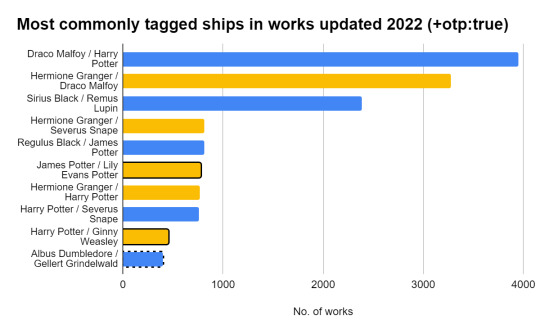
very pretty spread of (canon gender, not AO3 category) F/M & M/M ships here.
notable: there is not a single snape ship in the first list, and two snape ships in the second (sevmione at #4 !! and snarry at #8). grindeldore is the other new entry, and
romione, dorlene and regulus & sirius fell out of the top 10
this is probably a better view though:

a mix of all ships in either of the top two graphs (excluding the platonic ship regulus & sirius by definition of the otp:true filter), plus remadora.
open to more ship suggestions, but at some point i need to think about a size cutoff
anyway: some interesting strata here:
snarry+sevmione at the >60-70% mark. (do all snape ships show this trend? just crossgen snape ships? what about other crossgen ships? to be investigated)
grindeldore is an expected outlier due to the different canonical time period
marauders era tends to have more fics-with-multiple-tagged-ships. unexpected - there are so many more named lightning gen characters! lightning gen fandom more splintered/fragmented?
clustering of canon couples at the 15-20% mark, surprisingly consistent across marauders vs lightning gen
oooooo i could soapbox about this dorlene outlier for days. (tldr: if you want to write OFCxOFC that's all well and good, but writing OFCxOFC as what's quite clearly a background ship and a background ship alone? i think we can do better.)
Multi-shipping & ship overlap
marauders era is dominated by one main fanon pairing. no other “/” pairing with either of these two characters makes the top 10 list. in contrast, wrt lightning gen, Draco, Harry, and Hermione are all shipped with each other, with all three combinations making the top 10 list.
there is one pair of marauders era ships with ship overlap, though. which means stats! also included remadora as an additional comparison point since that's another big overlapping ship

jegulus AND jily are tagged in 675 works, out of 3944 works (17%) where all three of james, lily, and regulus are tagged.
meanwhile drarry + dramione: 80 works tagging both ships, out of 8128 works tagging all 3 characters, with an overlap of <1% fics tagging both ships. these two do not mix.
actually ykw this all was very funny
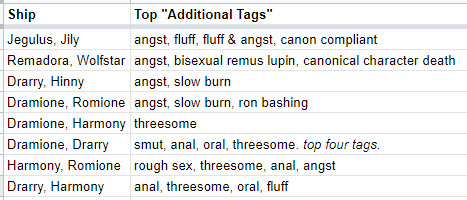
---
✨ FEMSLASH! ✨
filters used: english, no crossovers, works updated between 2022-01-01 and 2022-12-31, and category:F/F.

ok so that's a complete nonstarter 😂
tried two ways of filtering down to just femslash ships without losing too much else in the process:
1) excluding works tagged M/M, F/M, and Gen (leaving 2765 fics)
dashed outline = cross-gen ship. solid = marauders gen. everything else = lightning gen.

oh, interesting, people are writing genderbend wolfstar? *checks fics* -- no they're not. 'nuff said.
2) instead, tried adding the otp:true filter (2402 fics)

very similar results -- both lists had the same 9 femslash ships. Bellamione (#1 on both), Fleurmione (#2), Pansmione (#3/#4), Dorlene (#3/#5), Linny (#4/#6), Cissamione (#5/#6), Ginmione (#7/#9), Marylily (#7/#9), Ginsy (#8/#10).
i don't see any obvious trends re. which ships are ranked higher on one list vs the other.
a real quick rating comparison between categories, using the otp:true filter:

"angst" and "fluff" were the top two tags used for most categories so i decided to try a bit of:

<1 = more angst works than fluff, >1 = more fluff works than angst.
the other top tags for each category:
F/F and F/M: both romance (#3)
M/M: established relationship (#3)
Multi: polyamory (#3)
Other: au canon divergence (#3). "other" was used to refer to a mix of NB/trans character, thingfic, and x reader.
Gen: au canon divergence (#1). i was worried about using the otp:true filter for gen fic but the top two tags were indeed & tags (harry & severus, regulus & sirius).
243 notes
·
View notes
Text
fakemon concepts
so, you’re still thinking about making one of those pokemon creatures: the question is, what kind of pokemon creature do you want to make?
how to concept
before we get to actually designing the pokemon, you’ll first want to come up with a strong concept. this is what your pokemon is actually about, its core conceit, what makes it special! a strong concept will guide your design and tell you exactly what your pokemon should look like, in terms of physical characteristics, pose, and personality.
disclaimer: pokemon concepts have evolved over the generations, which is really only to be expected from an almost 30-year-old franchise. pokemon concepts will continue to evolve over time. I’m not going to be the judge to say “this looks like a pokemon” or not, mostly because they release new and surprising pokemon every year and I always find myself liking them anyway. these are just a few frameworks that will hopefully help you navigate fakemon design.
anyway.
the fundamentals
pokemon concepts are often made up of multiple parts: where the skill lies is in pairing parts that go well with each other. for example, bulbasaur is a bulb-frog that evolves into a flower-dinosaur. confusing? yes, when I put it like that. but what makes it work is the narrative that ties the pokemon together (a rafflesia growing and bursting into bloom). so,
pick a base concept. easy tier would be an animal, plant, or object (1), but feel free to go further! many of the more anthromorphic pokemon are based around ideas or professions rather than a specific animal. think of snorlax (hungry sleepy animal, not actually a bear) or kirlia (a ballet dancer). pick a base that’s evocative and flexible. the base should be something that would be familiar to a child, if not in specifics then at least in general. (2)
find a secondary concept. the secondary concept does not need to relate to your base concept, but it should have synergy with it, IE they should resonate with each other and make it easier, rather than harder, to understand your pokemon on first glance.
marry these concepts together using a narrative and personality. your pokemon should tell its own mini-story. how does it function in the wild? how does it behave in relation to humans? what are its likes and dislikes? at this point, you may start filling out the laundry list of pokemon traits (post upcoming), like their typing, evolution stage, pokedex entries, stats, and so on. (3)
does this pokemon go with other pokemon? if so, you might need to think about those pokemon too! like real life critters, they can have a variety of relationships, be it mutualistic or antagonistic or anything along those lines. if this pokemon evolves, think about how its core idea evolves through the different stages (as opposed to just getting bigger and more complexly designed). you can go through this process for those guys too!
happy with your fakemon concept? good! now is time to refine your concept further. here is a DIAGRAM I have made for your reference.
pokemon graph 01

you’re probably looking at this like. what the hell does THAT mean??? but you also probably get it from looking at it. all pokemon fall on this diagram somewhere. you should try to stay within the pale red diamond, otherwise known as “the pokemon zone”. here are why I labelled the axes as such:
a zoo animal is a pokemon that’s too familiar for anyone’s liking. it does not necessarily need to be an animal, that’s just the name I’m using for it. this often happens if you lean too hard on your base concept and make your pokemon wayyy too specific. like if you made a mantis shrimp but it’s just a mantis shrimp. yes, it’s very cool, because mantis shrimp are fundamentally cool, but at the end of the day, it’s still basically just a mantis shrimp with no other significant traits. again, “zoo animal” can also apply to more humanlike concepts - this happens when you make a pokemon’s assigned characteristics too clear in its design. remember: timburr has a vest and carries a steel bar, but it does NOT wear a hat and its vest is not high-vis. try simplifying and abstracting if this is you.
a furby is a pokemon that is unearthly to the point of unfamiliarity. I mean, yes, strictly speaking all pokemon are unearthly, but this is a pokemon that’s so unfamiliar it’s hard to parse on first glance what’s going on with it. often this has to do with missing the mark on pokemon design conventions, but the existing pokemon I’d place close to this are actually ultra beasts, which are like this by design. they do this by doing things like having uncomfortably and satirically humanoid silhouettes, missing faces and facial expressions, being full abominations and so on. there are some really interesting things you can do in this space, but you want to still make sure this pokemon is interesting and likeable to a child.
a digimon is, well, a digimon. there are plenty of theses on why digimon are different from pokemon, but personally the main difference is in the scale of design: digimon tend to be much more anthropomorphic and also much more complicated, with the addition of armour and clothing. when a pokemon (such as lucario or gardevoir) is anthro, they aren’t straightforwardly so - they mess with the proportions, they disrupt the silhouette. they also don't straightforwardly add clothes; usually the clothes are baked into the pokemon's fur or skin to give an impression (such as with gumshoos). people fall into the digimon trap when they overcomplicate their design by adding too many elements into it.
a neopet is also, well. a neopet. unlike digimon, neopets tend to be undercomplicated and oversimplified. instead of having the secondary concept, they tend to have a single concept with a personality tacked onto it. not all cute pokemon are neopets, and not all neopets are cute pokemon. for example, eevee looks like it could be a neopet, but is specifically designed to be no particular animal, as well as having a unique concept behind its evolution and relation to other pokemon. if you’ve got a neopet-looking pokemon, try to make its concept more complex (although not necessarily more convoluted).
you might have noticed that I’ve mentioned that certain existing pokemon lean one way or another, but are still considered pokemon. this is because pokemon changes all the time and is constantly pushing the definition of what it means to be a pokemon. as I said, making fakemon is meant to be fun! do whatever! but pokemon official is able to do this because they are aware of pokemon design conventions to begin with. that’s why ultra beasts are Labelled As Ultra Beasts, it’s because they don’t fit the design conventions. keep this in mind when conceptualising your pokemon!
appeal to children
think your fakemon sounds like a fakemon? cool. now you want to make sure your fakemon hits the right tone, and for that, it must be parseable to a child.
like, a kid should be able to listen to your concept and be like oh that makes sense and not get lost along the way. this is because despite the ageing fanbase, one of the cornerstones of pokemon remains being accessible to new and young players, rather than just old veterans. if it’s too complex, streamline your ideas! if it’s too simple, buff up the narrative! every pokemon should, theoretically, be able to become some child’s best friend and companion.
if you’re struggling to figure out how to do this, one thing I’ve found very helpful is actually relying on the frameworks pokemon already gives us in game. that is, your pokemon’s condition!
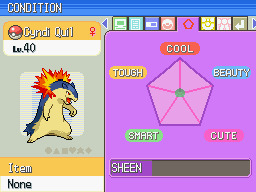
in-game, pokemon are used in contests, and their condition is part of their judging. for fakemon, this means you can use these stats to guide the appeal of your pokemon:
tough
cool
beauty
cute
smart
or any combination of these! most pokemon (I find) tend to lean on 2 of these characteristics. a pokemon can be large and brutish, but it must be scary in a cool way. in an exciting way! in a “wow that’s so sick I wish I had one of those” kind of way. note also that conditions tend to lend themselves to certain kinds of moves, builds, and stats, but if you’ve been following along with a fakemon in mind that should probably make sense to you anyway.
now that you’ve thoroughly refined your pokemon concept, it’s time to put your pokemon in context.
cultural concepts (and appropriation)
okay, listen. if you are making a fakemon, there’s a good chance you’re thinking of making a fakemon region, or pokedex. like the pokemon company, you’re probably considering basing it on a real-world geographic area and culture. and that’s not bad! but you need to be careful!
I’m not saying that you should only write or make art about cultures that you personally are familiar with, but please for the love of god do not make racist fakemon. I have seen enough racist fakemon for a lifetime. think about the appropriateness of the story you’re telling. are you the right person to tell this story? is this story yours to tell?
as a creator it is your responsibility to research thoroughly any other culture you seek to represent, especially their mythology. this includes being sensitive to their perspective on said culture, which may have religious or otherwise implications that you aren’t aware of. I am once again asking you to be, at the bare minimum, respectful. (4)
if you’re working on a culture that isn’t yours, look into getting a sensitivity reader! I assure you that this is not as scary as it sounds, and could be as simple as asking a friend from that culture to look over your work and point out any blind spots. (if you don’t have any friends from that culture, this should doubly make you question why you’re making fakemon about it, of all things.) please also thank your friend for their time - sensitivity reading is also a job that people get paid for, if you’d like to hire someone instead.
anyway, key points:
if you’re representing a culture or background that isn’t yours, do your research
part of that research may involve speaking to people from that culture or background to actually make the pokemon work
this is not a bad thing and will in fact help you make better pokemon
ultimately the goal of any culturally inspired pokemon should be to celebrate that culture! not to perpetuate racist stereotypes lol
conclusion
a lot of people think that pokemon is often X + Y = Z. they’re not wrong, but it’s actually more like A + B + C + D + E = Z, where A to E aren’t just different things, they’re different categories of things. A might be your base concept. B might be the weird riff you’re putting on it. C might be a personality trait. D is the narrative role of the pokemon. and E is probably the completely broken unique move or ability you’ve concocted for your pokemon that would make it horrible to play against competitively.
make your pokemon rigourously! make them robust! make them fun! and ultimately, please make them a child’s best friend, to go on their pokemon journey with.
footnotes:
(1) I guess a sort of riff on animal, vegetable, mineral, except that pokemon objectmons go far beyond minerals. grass types aren’t all strictly plants, and vegetables do encompass mushrooms though.
(2) a child might not be familiar with the specific parasite that orbeetle is based on, but they do know ladybugs and they do know UFOs. and they’d be like, wow, so cool!
(3) please know that even though I’ve labelled these steps 1-4, you don’t have to actually do them in order. you could start with a typing you want to fill or a narrative in mind, then come up with a pokemon to fill the gaps. start with a design and then make up a personality for it! I’m not the boss of you.
(4) I’m not going to pretend pokemon doesn’t have its own history of cultural appropriation and racism (cc xatu, jynx, etc.). but that doesn’t mean you have to do it.
49 notes
·
View notes
Text
Who appears the most in Io Sono Macchia Nera?
I recently found this website, by Matthew Stewart, called Screen Time Central that collects how much different characters appear in various movies. I thought it would be interesting to do the same with Disney Comics, so here is stats on who appeared the most in Io Sono Macchia Nera (AKA I'm The Phantom Blot).
Scuttle - 1 (panel) / 0,33% (of the story)
Horace - 2 / 0,66%
Clarabelle - 5 / 1,64%
Petulia - 6 / 1,97%
Casey - 14 / 4,61%
Jacob - 20 / 6,58%
Minnie - 23 / 7,57%
Goofy - 27 / 8,88%
Blot - 32 / 10,53%
O'Hara - 35 / 11,51%
Mickey - 175 / 57,57%
(My thoughts and additional stats below!)
These are all the characters Inducks lists as being in the story. With the addition of Jacob, who I added myself despite the fact that he isn't on Inducks, since he is an original character.
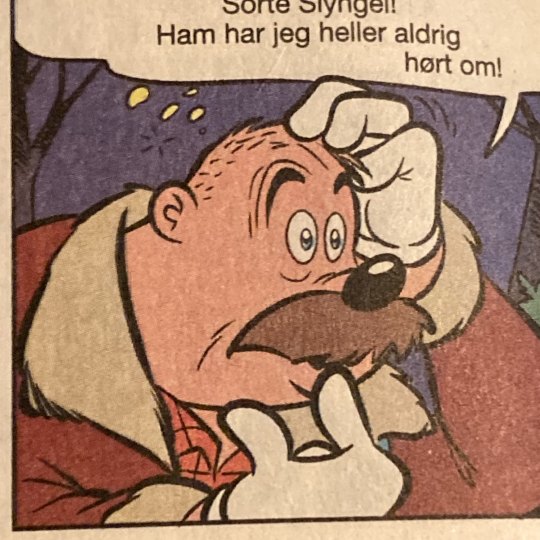
(This is who I mean with Jacob by the way).
Matthew Stewart usually uses the Oscars as a way at looking at screentimes, so I'll group in types of characters as either "leading" and "supporting" here (although mostly because I think it's a very intuitive system for this!).
What's interesting is that here in Denmark this story was listed as a Phantom Blot led story. Yet he, as it turns out, only appears in a little over 10% of it.
Looking purely at the stats you might be quick to make the conclusion that this was wrong and that it's obviously a Mickey lead story. However, if you've read the story you'd probably agree that the Blot is leading and not supporting. In fact I would say that he is the singular lead of the story with Mickey acting as a secondary.
This is for a lot of reason, most just being the feeling you get when you read it. The main point is that we view most of the story through the point of view of the story. I won't go more in detail here, because I think you would agree with me if you read the story, let me know if you don't and I'll explain myself more in detail!
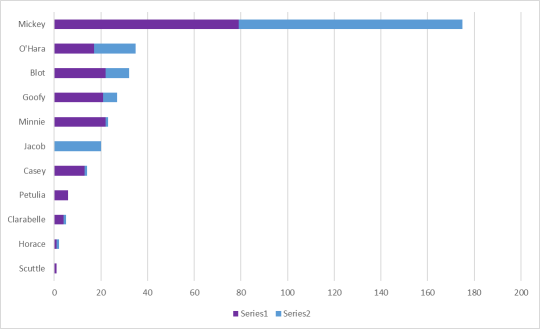
Here is a graph that contains the data. I split this one in to parts.
Additionally, I also wanted to count the entry and exit spots of each character. So, here is where we see each character for the first and the last time:
Blot - 5 (1,64%) / 258 (84,87%)
Scuttle - 14 (4,61%) / 14 (4,61%)
O'Hara - 15 (4,93%) / 300 (98,68%)
Casey - 15 (4,93%) / 276 (90,79%)
Mickey - 32 (10,53%) / 302 (99,34%)
Minnie - 32 (10,53%) / 302 (99,34%)
Goofy - 32 (10,53%) / 268 (88,16%)
Petulia - 37 (12,17%) / 136 (44,74%)
Horace - 71 (23,36%) / 275 (90,46%)
Clarabelle - 72 (23,68%) / 275 (90,46%)
Jacob - 175 (57,57%) / 274 (90,13%)
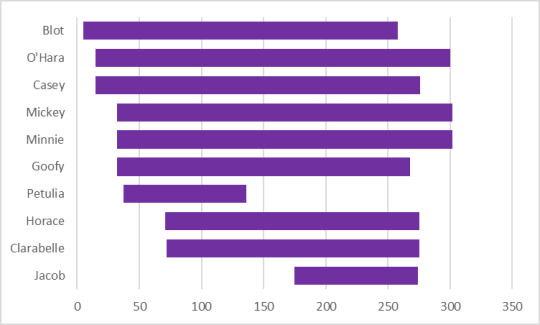
And here is that in a chart as well!
That was it! Obviously take these numbers with a grain of salt, as I almost certainly made some counting mistakes...
#disney comics#phantom blot#statistics#this took a while to write#and took a while to count as well...
8 notes
·
View notes
Text
By: Ryan Burge
Published: Apr 29, 2024
Sometimes I write a piece and a few weeks later I completely forget that I published it. I am not going to point out any specific examples on this Substack, but rest assured there are numerous occurrences where I've Googled an answer to a question and stumbled upon an article that I wrote at some point in my career, only to have forgotten about it entirely. As one of my homiletics professors said during my undergraduate studies, "not all sermons can be home runs." The same goes for public writing, I suppose.
But there are some little threads that I have exposed in earlier work that I just can’t shake. Sometimes, this is a result of giving a talk that goes really well and drives a lively Q&A, which then gets my mind spinning with possibilities. This was certainly the case when I was at Asbury University a few weeks ago, presenting some graphs from two posts that have run on Graphs about Religion.
They both circle around this idea that I have been exploring for a while—that religion doesn’t mean what most people think it means. Increasingly, it’s not some kind of theological ascent where people come to a clear understanding of Jesus, Mohammad, nirvana, etc. I just don’t think that’s how religion works in 21st-century American life. Instead, I believe that religion has been reduced to little more than a tribal marker, much in the same way that people say they are a fan of the Yankees, or they are Irish, or graduated from Stanford. It’s a way to create an "us vs. them" dynamic.
But there’s more evidence for this theory, too. There’s an increasing number of people who say that they are evangelical, yet they go to church less than once a year. Or, there’s a growing phenomenon of non-Christian faith groups like Jews, Muslims, and Buddhists who will tell survey administrators that they too are evangelicals. As I have shown, it’s pretty easy to predict why this is happening—it’s much more prominent among Republican non-Christians than among Democrats. Religion is not about a sense of the Divine; it’s about what tribe you associate with and what kind of cable news you consume.
So, consider this another entry into that larger discourse. This time I wanted to zero in on a small subset of people that I just can’t stop thinking about. Here’s the setup:
There are a handful of religion questions on mainstream surveys. One is, “How important is religion in your life?” Responses range from "not at all important" to "very important." They are also asked, “aside from weddings and funerals, how often do you attend religious services?” with response options that go from "never" to "more than once a week." Let me just show you how the sample breaks down on these two metrics in a heatmap.
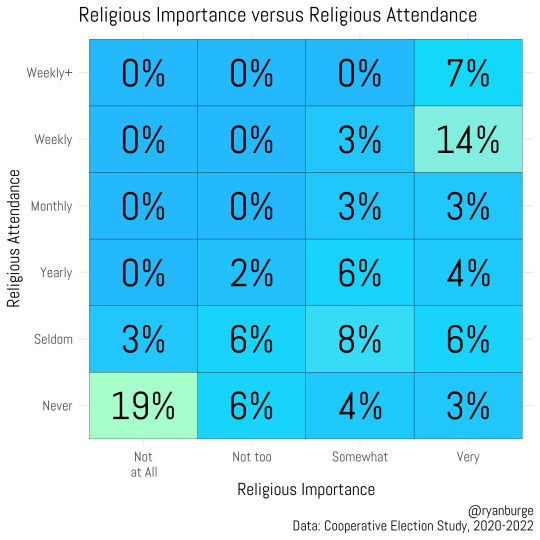
It should come as little surprise that the top left is sparse. Not a ton of people are high attenders but don’t think that religion is very important. That would be completely nonsensical. The most populated square is the bottom left—those who say that religion is not at all important and they never attend religious services—about one in five Americans fall into this box. In fact, the bottom left four boxes comprise about a third of the entire sample—that’s low attendance and low importance.
In contrast, about 7% of folks attend more than once a week and say that religion is very important. The top right four boxes equal about a quarter of the sample—those are the more religious folks.
But look at the bottom right, that’s where I wanted to focus my attention for this post. Specifically on people who meet two criteria:
They say that religion is very important.
They report their religious attendance as seldom or never.
In the sample from the last couple of years, that equals about 9% of folks. That’s not nothing. In fact, if you extrapolate that out to the adult population of the United States, that might mean 20-25 million people are high importance/low attendance.
Is there a growing trend, though? Are more and more people saying that they think religion is important, then just not showing up for a weekend service?
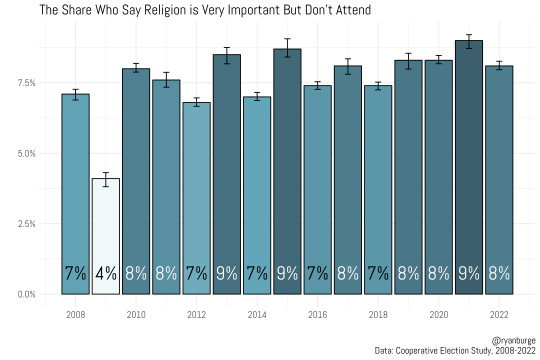
I’m not sure if that’s the case or not. There may be an increase in the trend line, but it’s not a huge one. Between 2008 and 2012 (let’s exclude 2009 as an outlier), I’m pretty confident in saying 7-8% met this criterion. But that figure has slowly crept up over time. Now, since 2019, the share who check both these boxes is likely in the 8-9% range. So, I think it’s fair to say that it’s a growing phenomenon, but not a rapidly growing one.
But I had to look under the hood of this one just a bit. Are there certain factors that seem to be driving this phenomenon of cultural religious people? Obviously, politics was the first thing that came to mind. So, here’s the trend line for Democrats, Independents, and Republicans between 2008 and 2022.
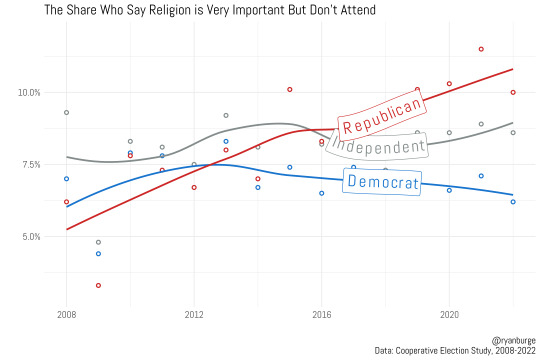
Okay, now I think we can see a clear shift. Among Democrats, the share who say that religion is very important but don’t go to church is stable over time. It was about 6% of them in 2008, and it’s essentially the same share today. For Independents, it’s probably a modest increase. It hovered around 7.5% for a while during Obama’s first term, then began to slowly creep up. Now, it’s probably the case that 8.5-9% fall into this camp.
But among Republicans, there’s no mistaking what is happening here. The share who are culturally religious has risen quickly. It was about 5% of all Republicans in 2008 who said that religion was very important but they attended services less than once a year. The trend line in 2022 was just about 11%. So, today, a Republican is twice as likely to be culturally religious compared to a Democrat.
I had to take a look at age, but I really had to think about how to visualize this in a way that is not deceiving. Because there’s a big problem when you combine two metrics like this: a lot more older people say that religion is very important compared to young adults. In fact, it’s 50% of those in their seventies, versus just about a quarter of college-aged young people. So, of course, more older people are going to be culturally religious, just based on that criterion.
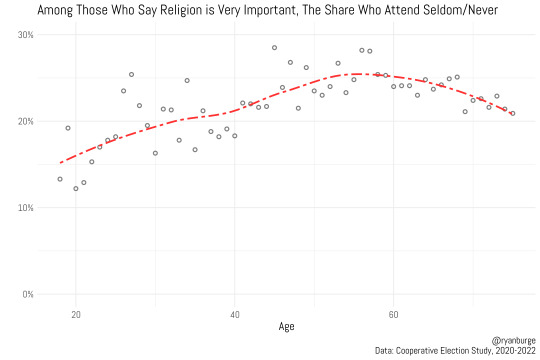
So, I had to switch it up a little. I restricted the sample to just people who said that religion was very important, and then I calculated the share who described their religious attendance as seldom or never. This gets us closer to the actual reality.
About 15% of younger folks place a high value on religion but just don’t go to religious services, but the share begins to climb from that low point. Among 40-year-olds, it’s just slightly more than 20% who are in the seldom/never category of attendance. It really peaks among people in their fifties. Among 55-year-olds who say that religion is very important, a quarter go to church less than once a year. It does decline a bit beyond that point, but it’s still north of 20% even among folks in their seventies.
I wanted to put a little bow on this post by putting all this to a more rigorous test—a regression analysis. The dependent variable is identifying as culturally religious (religion is very important + I attend less than once a year). I threw all the basic suspects into the model—age, income, gender, race, education, and political conservatism. This model is awesome because everything is predictive in one way or another. That’s not usually the case.
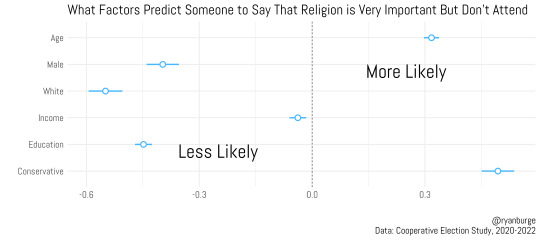
There are four factors that predict a lower likelihood of being culturally religious: income, education, being white, and being male. The one with the largest coefficient is race. A white respondent is significantly less likely to be culturally religious compared to people of color. This is followed by gender and education. The least predictive is income, but it’s still statistically significant. All drive a lower likelihood of cultural Christianity.
There were two factors that make someone more likely to say that religion is very important but they don’t go to church: age and political conservatism. All things being held equal, older people are more likely to be culturally religious. The same is true for being a conservative.
I don’t why but I can’t stop conjuring an image in my mind when I was thinking through this data - this is Andy Griffith Show fans. It ran for eight seasons in the 1960s. In many ways it’s the most wholesome show you can get. No sex, no drugs, no swearing. Just good morals. Ted Koppel went to a small town in North Carolina that was Griffith’s birthplace. It’s revitalized it’s economy by becoming a haven for tourists to revisit a bygone era.
They like the clean, wholesome nature of Mayberry. They watched the show as kids. They want to go back to that earlier time. But they just can’t manage to make it to church. They want to recreate the era of Andy Griffith, but not expend the actual effort of sitting in a pew on a Sunday morning. It’s just another example of people who like the idea of religion, but not the actual religious part.
#Ryan Burge#culturally religious#cultural christianity#empty the pews#decline of religion#religion#christianity#religion is a mental illness
5 notes
·
View notes
Text
Ranking the Doraemon Movies

Having watched (or rewatched) and reviewed every Doraemon movie released up to this point, the temptation to rank them is hard to resist. I’ll stress that the following ranking is of course based on my own opinions and I can’t pretend to represent any sort of consensus viewpoint. The Doraemon films have played with such a wide variety of settings and story genres that it’d only be natural for different viewers’ rankings to differ dramatically based on personal taste.
It’s striking to me that even after over 40 installments, there are very few Doraemon movies that I’d outright consider “not worth watching”. Not only that, but each cinematic storyline manages to do something that sets itself apart from the others (excluding remakes, that’s a total of 36 unique narratives to date). Considering how easy it would be for the nearly annual releases of such a long-running, popular franchise to descend into staleness and mediocrity, that is quite an achievement. No, not every Doraemon film is a winner, and I’m not going to claim that even my favorite movies in the franchise are the pinnacle of animated entertainment. However, if you enjoy family-friendly science fiction about adventure and friendship, there are certainly worse ways to spend an evening than with a Doraemon movie that has an enticing premise.
Full ranking (with links to individual reviews) below the break...
Note that for reasons given in my review, the original Nobita and the Haunts of Evil (1982) is disqualified from ranking.
From highest to lowest rated:
Nobita and the Birth of Japan (2016)
Nobita’s Great Adventure into the Underworld (1984)
Nobita and the Kingdom of Clouds (1992)
New Nobita’s Great Demon (2014)
Nobita’s Little Star Wars 2021 (2022)
Nobita’s Little Star Wars (1985)
Nobita’s Three Visionary Swordsmen (1994)
Nobita and the Steel Troops (1986)
Nobita’s Diary on the Creation of the World (1995)
Nobita and the Windmasters (2003)
Nobita’s New Dinosaur (2020)
Nobita and the Legend of the Sun King (2000)
Nobita in the Robot Kingdom (2002)
Nobita’s Chronicle of the Moon Exploration (2019)
Nobita and the Tin Labyrinth (1993)
Nobita’s Dinosaur (1980)
Nobita’s Dinosaur (2006)
Nobita and the Castle of the Undersea Devil (1983)
Nobita and the Galaxy Super-express (1996)
Nobita and the Winged Braves (2001)
Nobita in the Wan-Nyan Spacetime Odyssey (2004)
Nobita’s Treasure Island (2018)
Nobita’s Secret Gadget Museum (2013)
Nobita’s Great Adventure in the Antarctic Kachi Kochi (2017)
Nobita and the Animal Planet (1990)
The Records of Nobita, Spaceblazer (1981)
Nobita and the Birth of Japan (1989)
Stand by Me Doraemon 2 (2020)
Nobita and the Knights on Dinosaurs (1987)
The Record of Nobita’s Parallel Visit to the West (1988)
Nobita and the New Steel Troops (2011)
Nobita and the Spiral City (1997)
Nobita and the Green Giant Legend (2008)
Nobita Drifts in the Universe (1999)
The New Record of Nobita’s Spaceblazer (2009)
Nobita’s Space Heroes (2015)
Nobita’s Dorabian Nights (1991)
Stand by Me Doraemon (2014)
Nobita’s New Great Adventure into the Underworld (2007)
Nobita’s Great Adventure in the South Seas (1998)
Nobita and the Island of Miracles (2012)
Nobita’s Great Battle of the Mermaid King (2010)
Also, because I have to be a dork about this, I made a graph of this ranking with the movies ordered by release date. Each film is assigned a score based on its ranking, with the highest-rated having a score of 42 and the lowest-rated having a score of 1. The green line on the left separates the entries produced within the manga author Fujiko F. Fujio’s lifetime from those that came afterward, whereas the green line on the right marks the beginning of the 2005 anime reboot.

It’s interesting to see where the rises and dips are (or so I think). Looks like I’m not a fan of most movies that came out during the first decade of the anime reboot! More recent Doraemon films, however, have started rising in the ranks again. I look forward to seeing this year’s movie!
38 notes
·
View notes
Note
Nightswimming working for WIP Wednesday, and also want to know how do you do your chart <3 (You maybe already say but I don't remember!)
Once the door was shut, Steve flopped down onto the bed. “Huh. It’s weird,” he said.
“What is? All of this?”
“My mom. She never let any of my old friends call her Diane.” He sat up. “Maybe she likes you.”
“Maybe she thinks I saved your life in the mall.”
“You kind of did.” He reached over and grabbed her hand.
(make me write)
I would try to see if I posted about it before, but tumblr search function is shit and I don't know what I would've tagged it. Basically, I have a bunch of worksheets in a spreadsheet file. The first one tracks each thing I work on by day and wordcount. I add new lines and update it daily, or whenever I'm working:

Second sheet tracks total words per day. It's calculated automatically from the first one. I just need to add a new line each day, copied from the line below it. I included the sumif formula for the words in the screenshot:

Third sheet is progress by week, with columns per work. I could add those columns to the daily sum but it seems unnecessary. It automatically adds a new week when the time comes, but then I have to go down to the bottom row and make sure the data from the oldest week is populated:

But the graph in particular is on the fourth sheet. It uses the data from the first sheet to find sums for the past 7-8 days (depending if I put the top entry as =TODAY() or =TODAY()-1) then it sums those up and I can use that data specifically for the graph:
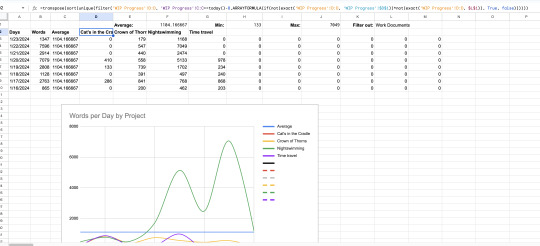
I have at least one more sheet that pulls graphs on data from the weekly sheet and the daily sheet, so I can see my trends:

But that's more so I can know that my progress is predictable, to a point. My Steddie Bigbang one is particularly funny:
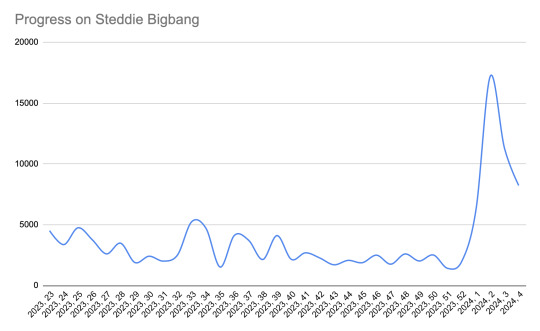
It takes a lot of playing around with spreadsheet formula to get the data to calculate automatically, and every couple of months I tweak it a little to see something else. Sometimes I break it completely and have to spend time fixing it. But, it works well enough.
The word totals aren't entered automatically. I have to do wordcounts from my documents to get them. I could change that by using APIs, but I think if I did, then I would be more likely to screw something in how I keep my docs. The manual step is better for me right now.
#nightswimming#steddie bigbang#wip wednesday game#my writing#stranger things#steddie#fun with graphs#life and times of eriquin
5 notes
·
View notes
Text
A Tug of War




Life lately feels like a bit of a tug of war, a never ending vigilance to fight extremes.
Case in point: some time ago I found this old bookmark tucked in an old manga of mine. I was browsing my shelves and remembered the bookmark is from a trip to Japan in 2017. The nostalgia instantly felt like a thousand anvils tied on my ankles. It was so easy to sink into missing everything from that time six years ago. And yet since then there have been so much goodness in my life. I live well and I am most content. When my first thought was crippling despair about a sense of unexplainable loss, my true feelings about it are that of gratitude and relief and inspiration.
I don't know why I'm predisposed to such mental traps. It seems so restless in my head. I find I have to always steer my mind so constantly. And look, I know my strength. I know I can win over this fickle, whiny, belligerent little child of a mind that I have. But I do wish it wouldn't be such a struggle to maintain an even keel, especially when there's no reason to be so melancholy or anxious. Why did I have to be born difficult? My mother always did say that about me.


At times of frustration I look to my cats. I see them living their life quietly and in the moment. They are cautious but they know precisely what delights them, and they are loyal and constant to that joy. They chase their happiness without fear. There's never shame in the way they express their distaste. They don't worry needlessly about what has happened or what will. They love the sun and know how to get cosy on rainy days. They are always observing and it isn't very hard to amuse them. They take care of themselves. They are capable of deep affection for others because they understand their own independence.
Now, really, September has been a lovely month. I don't know why I've started with quite a negative thought. In general, my days have been productive and filled with adventures. I've got two concerts at the end of the month and there's Oktoberfest too. I'm not big on drinking but I thought I should experience it at least once. Also, it has been a tremendous reading month for me! It's safe to say I've conquered my reading slump, which is a good thing because wow, look at that graph. I was completely out of commission for two months lol.


From my desk I watched the tree in the backyard turn from green to orange, slowly, as each September day passed. It's mostly yellow now and soon it will become bare. I look forward to the thickening autumn. I will be spending some of it in the UK again like I did last year. And I will be visiting some countries I haven't been to after that. And then in December I'll be twenty eight. How strange to find myself feeling relief in getting older. I used to dread this. I can't seem to figure out why I did anymore.
The song for today's entry is from Kate Davis' debut album, which I consider to be one of the best debut albums I've ever listened to. This song was not a single so it's quite a deep cut. I don't even think she plays it live anymore actually. The first chorus goes:
Big transitions require impulse actions
Require loss
Which, is true enough. It's the nature of change. The sentiment is a tender one, but what gets me is the lyric additions at the end as the chords open up:
Big transitions require impulse actions
Require loss
And light
And love
I relate so deeply to this song, for many reasons but I enjoy that blip of optimism the most. I'm quite comfortable with loss because I'm used to it and it's easy enough to manage alone. But light and love is always dependent on other people. I generally don't have much faith in others but the song reminds me to try a little harder in that department.

I send you my affection. May you enjoy October with as much gusto as my orange boy enjoys his catnip pepino.
Until next time!
10 notes
·
View notes
Text
So my post about how you should draw (YOU SHOULD DRAW!) blew up beyond any precedent since my return to tumblr and someone in the FRANKLY KIND OF TERRIFYING NUMBER OF REBLOGS mentioned downloading a free DAW to make music and that got me thinking,
HOBBY SOFTWARE MEGAPOST GO
All of the below software is free to use, and most of it is Open Source (which is its own thing I recommend learning about, its entire existence and success gives me hope for humanity) so GO GET SOME TOOLS! Make things like nobody's watching and then SHOW IT TO THEM ANYWAY! Or don't! Even if you hide your work from the world (lord knows I do!!!) you will have created something! And it feels amazing to create something!
VISUAL ARTS:
Inkscape: Adobe Illustrator replacement, pretty solid if a bit quirky.
Krita: Painting software, if anything slightly overpowered and sometimes more complicated than you want, but can do bloody anything including advanced color management. A wonderful tool.
Blender: You have probably heard it is super hard to use. This is CONDITIONALLY true. Because the developers are working day and night to improve everything about it it's always getting better and now like, 80% of the hardness is just because 3D is hard.
Aside: Blender Grease Pencil - A subsystem in Blender is concerned with 2D animation and it is. Surprisingly good. Some annoying conventions but totally possible to literally make professional traditional 2D animation.
MUSIC:
LMMS: A free and open source DAW that can do a lot, except use most modern VST plugins. The practical upshot of this is that if you are just starting out with music it is totally serviceable but over time you might start to long for something with the ability to load hella plugins. (I'm currently trying out Reaper which has a long free trial and is technically nagware after that point...)
PlugData: You GOTTA TRY THIS, it's not mentally for everyone (not HARD exactly, just WEIRD) but if your brain works well with this kind of flow graph stuff it's a magical playground of music. (If you have heard of PureData, PlugData is based on it but has a lot of nice graphical upgrades and can work as a VST if you have a proper DAW)
Surge XT: A big ol' synthesizer plugin that also can run standalone and take midi input so you can technically use it to make music even if you don't have a DAW. If planning notes ahead of time sounds intimidating, but you can get your hands on a midi piano controller, this might actually be a great way to start out playing with music on your computer!
Bespoke Synth: Another open source DAW, but this one is... sort of exploded? Like PlugData you patch things together with cables but it has a wild electrified aesthetic and it can do piano rolls. Fun though!
GAME DEV:
Yeah that's right, game dev. You ABSOLUTELY can make video games with no experience or ability to code. I actually recommend video games as a way to learn how to code because the dopamine hits from making a character bumble around on a screen are enormously bigger than like. Calculating pi or something boring like that. ANYWAY:
Twine: Twine is what I might describe as sort of a zero-barrier game dev tool because you're literally writing a story except you can make it branch. It has programming features but you can sort of pick them up as you go. Lowest possible barrier to entry, especially if you write!
Godot: I use this engine all the time! It's got great tutorials all over the internet and is 100% FREE AND ALWAYS WILL BE. Technically there are more Unity tutorials out there, but Godot has plenty enough to learn how to do things. It's also SUPER LIGHTWEIGHT so you won't spend your precious hobby time waiting for the engine to load. There are absolutely successful games made with this but I think the best thing about it is that the shallow end of the learning curve is PRETTY OK ACTUALLY.
2 notes
·
View notes
Text
How Can a VB-MAPP App Simplify Data Collection and Analysis?

Applied Behavior Analysis (ABA) professionals and educators working with individuals on the autism spectrum understand the critical importance of data collection and analysis. One of the most widely used assessment tools in ABA therapy is the Verbal Behavior Milestones Assessment and Placement Program (VB-MAPP), which helps assess and track language and social skills development in individuals with autism. While the VB-MAPP is highly effective, manual data collection and analysis can be time-consuming and prone to errors. Fortunately, technology has stepped in to streamline this process with the development of VB-MAPP apps. In this comprehensive guide, we explore how a VB-MAPP app can simplify data collection and analysis, making the lives of ABA professionals and educators easier and more effective.
1. Real-time Data Entry:
VB-MAPP apps allow professionals to input data in real-time. Gone are the days of carrying around paper assessments and jotting down observations manually. With the convenience of a mobile app, therapists and educators can instantly record data during sessions, ensuring accuracy and timeliness.
2. Effortless Organization:
One of the standout features of VB-MAPP apps is their ability to organize data seamlessly. Data points are categorized, labeled, and stored electronically, eliminating the need for bulky binders filled with assessment sheets. This organized approach not only saves physical space but also simplifies data retrieval and review.
3. Instant Progress Tracking:
VB-MAPP apps provide immediate access to progress tracking. Professionals can view data trends, identify areas of improvement or concern, and adjust intervention strategies in real-time. This agility is crucial in tailoring ABA therapy to meet the unique needs of each individual.
4. Automated Analysis:
One of the most significant advantages of VB-MAPP apps is their ability to automate data analysis. These apps employ algorithms that process the collected data, generating graphs, charts, and reports. This automated analysis reduces the risk of human error and allows professionals to focus on interpreting the data rather than crunching numbers.
5. Customizable Reporting:
Every ABA therapy program is unique, and VB-MAPP apps recognize this diversity. Users can customize reports to match specific goals, objectives, and benchmarks. This level of personalization ensures that data analysis aligns with the individual's progress and targets areas requiring further attention.
6. Secure Data Storage:
VB-MAPP apps prioritize data security and confidentiality. Most apps offer secure cloud storage options, safeguarding sensitive information while allowing authorized team members to access the data when needed. This feature enhances collaboration among therapists, educators, and caregivers.
7. Integration Capabilities:
Many VB-MAPP apps offer integration with other software and platforms commonly used in ABA therapy and education. This interoperability streamlines the data collection and analysis process by allowing professionals to work within a familiar digital ecosystem.
8. User-friendly Interface:
VB-MAPP apps are designed with user-friendliness in mind. The interfaces are intuitive, making them accessible to professionals with varying levels of technological expertise. This accessibility ensures that even those less tech-savvy can benefit from these apps.
9. Cost and Time Efficiency:
By automating data collection and analysis, VB-MAPP apps save professionals considerable time and effort. This efficiency translates into cost savings for organizations and allows professionals to allocate more time to direct therapy and interaction with individuals with autism.
10. Continuous Support and Updates:
Developers of VB-MAPP apps are committed to improving their products. This means that users can expect continuous support and updates to enhance functionality, address issues, and adapt to changing needs in the field of ABA therapy and autism education.
In conclusion, VB-MAPP apps have revolutionized the way ABA professionals and educators collect and analyze data. These apps offer real-time data entry, effortless organization, automated analysis, and customizable reporting, all while ensuring data security and user-friendliness. By simplifying data collection and analysis, VB-MAPP apps empower professionals to provide more effective, personalized, and efficient support to individuals on the autism spectrum. As technology continues to advance, the role of VB-MAPP apps in ABA therapy and autism education is set to grow, improving the lives of both professionals and those they serve.
#vb mapp app#vb mapp training#vb mapp assessment online#aba training online#vb mapp scoring#aba online training
2 notes
·
View notes
Text

i remembered that i never posted this here so here is my yakuza games tierlist (only of ones i've experienced so no dead souls kenzan etc) and here is my reasoning for each under the cut: (warning: this shit is long as hell)
1a. yakuza 6. first of all, the only game in which i like kiryu instead of being ambivalent at best towards him outside of funny substory moments. the absolute best thing they could have done with him, especially with the dragon imagery/reputation always associated with him, was give him something to protect, fiercely. he's old and tired and stressed out and he's all out of patience. one of the first things he does is tell a cps guy to go fuck himself and kidnap a baby. and it's the first game where he actually feels Threatening rather than being in stoic pacifist mode all the time. i do think he was genuinely ready to kill joon-gi for example, and he did punch his entire son-in-law through a glass door.
joon-gi is in 6 which automatically gives it a tremendous amount of points because i love him as he is and then i retroactively love him more due to the fuckery in 7, but the hirose family and the general plot are good enough that, upon rewatching a playthrough, i wasn't gnawing my arm off the whole time waiting for him to show up, because the game is already phenomenal without him. i fully acknowledge that some games (mainly kiwami and 3) i only think highly of because of one specific character, but 6 would still be good even if you replaced joon-gi my absolute beloved who i am obsessed with, with literally anyone else. also the ending was cheapened by kiryu being brought back into the fray of course but that doesn't change the fact that even Thinking about the steps scene brings tears to my eyes. love that shit. also fujiwara's voice acting as yuta is so fucking good. especially when yuta is going through some shit and his voice sounds completely hoarse and broken, and the subtlety with which it's delivered in some scenes as if he's trying to hide how affected he is (in serena while nagumo is asleep comes to mind). all in all just super super good. i love yakuza 6.
1b. lost judgment. my first actual rgg experience i fully sat through after playing yakuza 0 for a few hours but not enjoying the gameplay nearly enough to bother continuing. lost judgment is what ignited my passion for the series and essentially served as my actual entry point since i'd given up on 0 for the time being, and for several years no less. lots of beloved characters but i also really appreciate the actual storyline, more than any mainline yakuza game in fact. the scene on the roof with sawa might be my favorite in the whole game. the side stories are also very good, especially the boxing club one in my opinion (it's also neat that the school side cases are entire storylines in lj). i also really enjoyed the motorcycle gang one, and the minigame for the dance club was the main reason i even bought the game for myself after having watched a full playthrough.
a lot of people claim that judgment was better than lj, especially in terms of writing, but in my opinion, the only places lj falls flat in terms of writing are kuwana's character (there is so much about him that should be interesting but he is just a piece of cardboard to me) and the way yagami wields sawa's name after a certain point in the story. it really becomes a "drink every time yagami says sawa-sensei" type deal, which is comedic at best and annoying at worst. but every other thing in the story is not only good, but there's something else very specific to my experience that i'd like to talk about.
lost judgment made me rethink the way i view storytelling. i talked about this on twitter a long time ago and made these graphs to represent the way the characters are presented in the narrative of most stories versus the way lost judgment feels, with the black line being the protagonist's path and the colored lines being the rest of the characters in the story.

if you can't tell what i'm talking about, don't worry too much about it. it's difficult for me to put into words and i doubt people would readily agree with my perspective (or even that it's a better way to handle storytelling) even if i did explain it perfectly. it's just something that i really appreciate, that this one game allowed me to walk away with something so major, especially as a writer myself.
2a. yakuza 0. i have been talking too much already from my goated with the sauce category so i will try to keep these next ones more concise. 0 obviously deserves respect for being the technical starting point (unfortunately resulting in retcons and inconsistencies because it wasn't actually the first game) but it's also a fantastic game on its own. mainly majima's side. you will see a running theme where i just can't really care much about what happens to kiryu except in 6 unfortunately. but the cast in 0 is huge and all the characters have things to love and hate about them and it's so easy to get attached to them, seemingly moreso than other yakuza games (or people just play 0 to get in and then don't play any games after that, so it seems like the characters are more popular. it's also easier to give them attention Because of 0 being the starting point, because you can still get new fans who aren't deep into the series to relate if you're drawing/writing/talking about stuff from 0).
all in all 0 is very good and definitely deserves the popular opinion of it being the best yakuza game, especially with the work it did to revive the series and give it life in the west in particular. it demands respect on principle in the same way the first game in any series does, even if that game (not 0) happens to suck or be hard to play, just because it established the series and allowed better, more fun games to be made later. y0 is nice because it doesn't have the caveats of "well you have to respect it BUT" it's just a good game.
2b. yakuza 7. where to even begin. first of all, ichiban is infinitely more fun of a protagonist than kiryu. i happen to be extremely critical of all protagonists in every piece of media because they tend bore me extremely easily which sucks because they're the main character so they get the most screentime and we're stuck with them forever. ichiban never has that problem where it feels like a drag to be with him at all times. i happen to hate the brawling gameplay of the mainline yakuza games (and i only use crane style in lost judgment because it's the most fun) so it being a turn based rpg is extremely good. i bought it both because i knew i would enjoy that gameplay (especially with breaker ichiban in the funeral suit, that's such a good flavor that i wish was the canon default for him rather than hero/freelancer but i understand why it's not), but also because i am completely obsessed with joon-gi and wanted to witness every line and detail of him for myself without having to hunt for all of it online (especially since i only like the jp dub).
joon-gi's whole thing is my favorite part of 7, but only by a small margin. the plot of y7 in general was something i was extremely absorbed in and intrigued by, and my favorite scene in the game was the first coin locker scene. i, like many people, feel like the ending was extremely cheapened by what happened, seemingly for no reason, and especially with it being presented as a total non sequitur, but i do love that it gave ichiban the ability to perfectly parallel my favorite scene, all the way from what must have been an hour into the game, if even.
i happen to love all the party members including eri, who i wish had an actual role rather than being an optional party member. most characters in this game, i liked or appreciated in some way (for example, i do appreciate aoki but. "like" is a stretch.) so it didn't feel like a pain in the ass to max everyone's drink links. one complaint about the drink links i have though is that zhao's made it clear that he was only a party member as an afterthought, because for some reason his direction was different from all the rest, which i can reasonably assume was because it was directed quite a while after all the rest.
2c. judgment. i said i would try to shut the fuck up and then didn't so let's try it here. love the characters, love the story, i just didn't enjoy it *quite* as much as lj. i like kuroiwa but i do think people who say he's better than soma in any way are insane and high on copium.
2d. ishin. my beloved. as the tier name says, this one is only as high up as it is because i love historical dramas, but holy shit. first of all, obviously i am very happy to see izo (nishiki) and hijikata (mine), especially considering ishin gives us the opportunity to see mine when he's not in the middle of a combination homosexual and existential crisis because there's nobody in particular he feels insane about and capitalism hasn't ruined his life. but characters aside, the ending to ishin resonated with me something fierce and i regularly quote ryoma's little monologue about the future to myself and it makes me very emotional. the future's secure in the hands of so many others we've never known, whose faces we've never seen, whose voices we've never heard.
3a. kiwami. i think the tier name says it all. i am here for nishiki's corruption arc and how incredibly interested i am in chewing on him. i also recently watched a playthrough of the original yakuza 1 on ps2 and. i have to say, the retcons to turn nishiki into an actual character were a godsend. because based on nishiki in kiwami, you can't tell how or why shindo and kanda ended up as the next patriarchs considering nishiki's entire downward spiral started when he killed a rapist, only for some lame ass sex pests to succeed him. but in yakuza 1, it kind of makes sense given the line that implies nishiki thinks beating kiryu in a fight will make yumi "his". it gives the impression that he's so much more shallow and that he only killed dojima not to protect someone he cared about but because he was encroaching on something (someone) he felt entitled to. kiwami's retcons here are gentle and make it feel much more like he loved yumi but wasn't a freak about it, and that he killed dojima to protect her for her, not for himself. in conclusion, nishiki hard carries the game.
3b. yakuza 3. i do hold so much love for mine, but luckily he is not the only good thing about the game. the orphanage is introduced, you have the ryudo family and especially rikiya, but mine remains the best part of the game to me. only thing he did wrong was the ableism but to be fair he was having a complete and utter gay moment and freaked the fuck out because daigo didn't wake up within 5 seconds.
4. yakuza 4. what can i say. akiyama was great, love his character and his story, and especially love the cutscene direction. i thought going back and utilizing the money explosion in y1 was very clever, and was impressed that they built an entire fleshed-out character around that. will confess that i literally have no idea why he has the slut reputation that the fandom slapped on him, but i also barely know anything about dead souls as of right now, so maybe he shows hole in that or something.
the parts of the game that were not akiyama. well. kiryu and tanimura were fine. saejima was not. initially it was fine, but the prison escape thing is highly cheapened by the fact that this man is fucking addicted to prison so you have to do it AGAIN in the very next game. not only that, and not only the extremely uncomfortable scene with haruka, but saejima suffers from the same problems ryuji and sayama do (i will get to them.), where the game overhypes the fuck out of them just for them to not really do much of anything. the rubber bullets thing is stupid but it doesn't change the fact that saejima *thought* he killed those people, i'm not saying he's actually a pussy for not having committed Real Murder (it's just that god forbid a playable yakuza character actually does a killing). it's just that he doesn't really have anything interesting to say or anything cool to do except that scene in purgatory where he humiliated the whole audience down there for not valuing human lives beyond ending them for entertainment. i was fine with him for a while before that due to not knowing any better yet, but it's now retroactively the only scene where i don't kind of hate him.
5. yakuza 5. guys? it's not good. saejima is addicted to prison and still not a well-executed character in the slightest, with baba being the only bright spot in his section (but still a bit overplayed). but shinada is y5's biggest problem. it's not just that i don't give a fuck about baseball, it's that you have to be EXTREMELY passionate about baseball to let the absolutely ridiculous and dragged out and, rather quickly, extremely predictable story slide. i spent months trying to get through yakuza 5 and hated the experience so much that i thought i just wasn't into yakuza anymore. then ishin came out and i loved that and i decided to just skip the rest of 5 and go straight to 6, only to discover 5 was the problem and i do still love yakuza so incredibly much. luckily, the start of 6 recaps the ending of 5, so finishing it wasn't even necessary. and thank god for that.
6. literally anything else you can think of.
7. kiwami 2. i am nowhere near enough of a misogynist nor a brainless homosexual to like anything about kiwami 2. the only people i see who like ryuji are the ones who are attracted to him which is beyond me. people who like sayama i can only conclude have zero standards for the way female characters are handled. let me dive into this the same way i've bitched on twitter about it 109280437127421897432 times.
first, i will just quickly mention again that ryuji and sayama have the same problem as saejima. the game itself hypes them up so much that they almost have no choice but to fall flat. but sayama falls so much fucking harder than ryuji. and so does yayoi. yayoi's thing is quick, so i will cover that first.
you are telling me. that this strong, scary, takes-no-shit woman. gets manhandled *without even being restrained* and needs kiryu to come save her. and then when openly sexually assaulted just gives shindo one pansy ass slap across the face. almost like it's a gag in a rather sexist comedy sketch. realistically, according to her character, she should have pulled out a dagger and killed that man the moment he tried to kiss her. unfortunately, she is a woman in yakuza kiwami 2.
but at least yayoi just has one scene where she is dragged relentlessly through the mud. sayama is stuck being a woman in yakuza kiwami 2 for the entire game. pretty much the first thing she does is get shot in the shoulder. the shoulder. and while any male character in these games would either shrug it off or die dramatically from a single non fatal injury depending on what point in the game you're at, sayama, for some reason, faints and develops a fever. which means she needs kiryu to carry her all through kamurocho. and then a bit after that, she calls him while he's out to tell him to buy her underwear. and then when he brings it to her, she reveals that she just got out of the shower and drops her towel in front of him. if you can't understand why it's infuriating that the only major female character besides the Small Child is treated this way, i genuinely don't know what to tell you. she then spends the rest of the game asking endless questions and acting flabbergasted by everything (me too, girl). only good thing she ever did was shoot that one guy. and then of course the ending is a make out scene. only for kiryu to never think about her again after her cameo in the beginning of 3 (referred to yumi, inexplicably, as the only woman he has ever loved in 6 (he loved her?????))
in conclusion. from what i can tell, people like kiwami 2 for the following reasons:
they like the gameplay
they want to fuck ryuji
they think sayama's girlbossing makes her a good female character
mix and match any of the above. this game's only redeeming quality is that emo phase daigo is funny (if completely pathetic)
if you actually read all this, thanks for hearing me out and i am deeply sorry you wasted your time on some guy on the internet's opinions.
#not tagging this with fucking anything so if the stans find me and get mad at which games i hate then that's tumblr's fault#di.txt
2 notes
·
View notes
Text
I have a quick rant regarding the star wars sequel trilogy and why it doesn't feel very satisfying by the end. Or, well, one of the reasons.
Basically, it comes down to narrative structure, specifically the three act story structure. Think of a line graph showing how well the heroes are doing. The higher the line goes, the better the heroes are doing.
The starting point doesn't matter. It starts going up during the first act, and during the second act it continues until a certain point when it suddenly drops down low. The third act is when the heroes rally together and the line goes right back up to the top.
A trilogy of movies usually follow this structure, with each entry being an act. For example: the Original Trilogy.
ANH starts off with the rebels successfully smuggling the Death Star plans, then despite some road blocks, they destroy the Death Star. Overall, the line trends upwards.
ESB starts off with the rebels on the back foot, but they all escape. Luke goes to his training on Dagobah, Han and Leia go to Bespin. The line is still going up! But then, Vader captures Han and Leia, and Luke abandons his training to save them. The line is started going down. Han is frozen in Carbonite, Leia escapes by the skin of her teeth, and Luke is defeated by Vader, losing his hand. The line has suddenly dropped down.
RotJ starts off with the rescue of Han, which starts the line off going up. They discover Endor, then successfully infiltrate the shield generator. Despite the whole thing being a trap, everything goes according to plan, and the good guys are eventually successful. The line is at the top.
But let's look at the sequel trilogy and plot that line, shall we?
TFA starts off with the new Empire clone, and the heroes get plans to the new Death Star clone, and they defeat it. Line goes up, identically to ANH.
TLJ has the new rebel clones on the back foot as they desperately try to escape the Empire clone. Rey goes to Ireland to learn from Jake Skywalker, but he's being rude so she quickly leaves. The low point of the movie has a bunch of characters about to be executed and defeated, but... Then everything goes well for the rest of the movie. The rebel clones escape, the Empire clone is defeated, and literally only one good guy person dies, but it's Jake so it's no big loss. The only downer of the movie is that nobody responded to the SOS quickly enough.
TRoS starts off with the rebel clones on the offensive against the Empire clone who is now led by the literal Palpatine clone. The heroes wander around for a bit until eventually they save the day. It also turns out that this time, everyone responded to the SOS call.
The thing is, the point where the line is supposed to go down doesn't really happen. The second movie, when the heroes are supposed to be at their lowest point, is kind of more like an inconvenience. Not only that, but the next movie actually erases that. The third movie starts out with the heroes almost having the full advantage. The empire clone is fracturing already.
Because of the lack of a low point, the success seems hollow. The low point had to be attempted in the third movie, and that didn't do much to help.
3 notes
·
View notes
Text
Amazon and Grubhub Partnership
Amazon has a new partnership with Grubhub (owned by Just Eat Takeaway) so now Amazon is back in the restaurant delivery business.

Amazon tried restaurant delivery but exited the business in 2019 after trying it for four years. The original plan in 2015, was to compete with Grubhub and other food delivery services. Amazon Prime members could place orders for food from restaurants and have it delivered with no delivery fees. Amazon seemed dedicated to this because they even had a division at Amazon called Amazon Restaurants.
Amazon apparently identified the restaurant delivery business as a strategic uncertainty and decided to exit the business. Amazon must have assessed the risk of negative impact to be very high. In my opinion, the timing of the exit was unfortunate because the Covid lockdowns began shortly after their exit from the food delivery business. But Amazon also apparently decided to monitor the food delivery industry after exiting because only 3 years later they are back in the business.
Another point of view is that Amazon could have been simply testing the industry, learning what they wanted to learn in the food delivery business then after the trial, decided there was a better way to make a profit in this category. Buying into a partnership instead of owning a restaurant delivery business might have been assessed to be a better use of Amazon resources. Grubhub is an established brand with experience and knowledge in the restaurant delivery business so maybe this partnership is a smart strategic move for both brands.
The timing for the re-entry into food delivery makes sense due to a change in the way we live, work, and eat as a result of the Covid pandemic. Food delivery services such as Instacart, Uber Eats, Deliveroo and Door Dash all experienced an acceleration in orders during the Covid lockdown. Although the surge in demand ceased, data on the food delivery services indicates that consumers who tried food delivery services during the lockdown liked what they tried.
Since Amazon started in the restaurant delivery business in 2015, the market has changed. There is more consumer demand but there is also more competition from other food and restaurant delivery services.
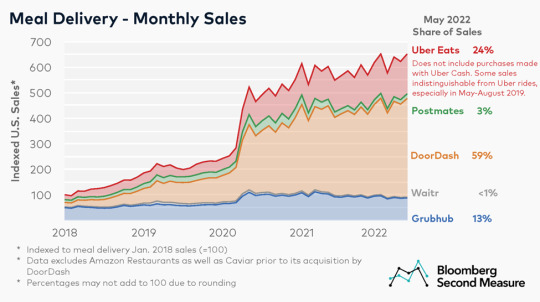
This graph shows that with the increase in demand comes new competitors and changes in market share. This is very characteristic of the growth stage of the Product Life Cycle (PLC) and this means all competitors will be shifting marketing strategies to defend their market share.
I find it interesting that Amazon is entering the fray (again) when there are so many competitors with more significant expertise than them in the food delivery category. They now have to compete against Door Dash’s 59 % market share and Uber Eats 24% market share.
Since Grubhub has only 13% market share, a big question I have is this: why Grubhub?
According to data published in Tech Crunch, Grub Hub has experienced consistent growth in Revenue each year since 2010. In 2010, Grubhub generated $8.5 million in revenue. At the end of 2021, Grubhub generated $2.1 Billion in annual revenue. That is impressive revenue for Grubhub and since Grubhub has the business model set up, it should be easy for Amazon to generate significant revenue without spending too heavily on existing Amazon resources. Additional impressive data about Grubhub is growth in the number of users. According to the chart below, Grubhub had 3.4 million users in 2013, at the end of 2021, Grubhub had 33.8 million users who purchase through the app once a month.Sources: Company data, Food Delivery App Report, TechCrunch.
Although Grubhub is a growing delivery business, I wonder what criteria Amazon used in their choice of Grub Hub. It is clear that Grub Hub has been consistently growing revenue and has grown in terms number of users but there must be something else that Amazon sees in this partnership. From a growth perspective, this is a good business for Grubhub but I still wonder what else Amazon knows about Grub Hub to make this their choice.
Although overall growth has been good for Grub Hub, their quarterly sales per customer has not seen the increase that competitors have seen (more than doubled for Uber Eats and Door Dash).

I have a lot of questions about Amazon’s decision. Why not go it alone? Do they still assess this as a strategic uncertainty and they are trying to minimize risk of failure?
Is it possible that their timing was wrong when they first tried this? Consumer patterns have changed since the pandemic and maybe many people that tried food delivery then found that they really benefit from a service like this and do it more often. Is it possible that more people like to eat at home than before and delivery gives people a restaurant food experience at home? Or, is it possible that Amazon did not give restaurant delivery a chance? What are their criteria for exiting a business?
The part that doesn’t make sense to me is the re- entering the restaurant delivery business after exiting only 3 years ago. This is Amazon, and we assume they have the talent, resources, assets etc. to have monitored the situation, gathered data, make changes, continue on without an exit from the business.
There are many more questions about Amazon’s decision. Was it a strategic decision (and brilliant) to partner with Grub Hub and essentially purchase their expertise, data, market share and revenue? Does this allow them to monitor this strategic uncertainty using fewer of their own resources? Was the original restaurant delivery business part of an experiment with something they will never reveal? Is the new Grubhub partnership and efficient way to offer Amazon Prime subscribers a new benefit at little cost to Amazon?
In my opinion, the re-entry is another test to gather data for something bigger in Amazon’s strategic plan for growth. In the meantime, they will have another benefit to add to the list of Amazon Prime membership benefits.
I look forward to following this story .
Sources:
https://techcrunch.com/2015/09/08/amazon-launches-a-food-delivery-service-via-prime-now-starting-in-seattle/
https://techcrunch.com/2019/06/11/amazon-restaurants-in-u-s-is-shutting-down/
https://techcrunch.com/2022/07/06/amazon-takes-a-prime-step-back-into-restaurant-delivery-in-the-us-with-new-grubhub-investment-and-partnership/
https://www.restaurantdive.com/news/amazon-restaurants-is-dead-but-the-e-tailer-is-still-hungry-for-food-deliv/556902/
3 notes
·
View notes
Text
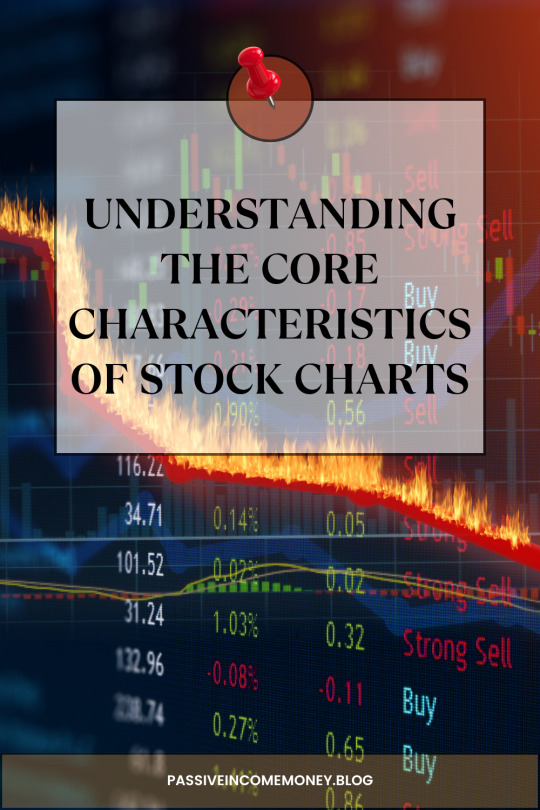
Understanding the Core Characteristics of Stock Charts
Stock charts are essential tools for traders and investors, providing a visual representation of a stock's price movement over time. These charts are not just random lines on a graph; they are a reflection of the stock's performance and are influenced by market sentiment, news, and economic events. To effectively utilize stock charts, one must understand their core characteristics and how to interpret them.
Timeframes
Timeframes are a fundamental aspect of stock charts, allowing traders to view price movements over different periods. Whether it's minutes, hours, days, months, or years, each timeframe can provide unique insights into the stock's behaviour. Short-term timeframes might be used for day trading, while long-term timeframes can be beneficial for investors looking to hold positions for longer periods.
Price and Volume
The vertical axis of a stock chart typically represents the stock price, while the horizontal axis represents time. Beneath the price chart, you'll often find the volume represented, which shows the number of shares traded during a given period. Volume is a significant indicator as it can confirm trends; an upward price movement with increasing volume can indicate strength in the trend.
Chart Types
There are various types of stock charts, but the most common ones include line charts, bar charts, and candlestick charts. Line charts are straightforward, tracing a stock's closing prices over time. Bar and candlestick charts provide more detailed information, showing opening, closing, and high, and low prices within a specific timeframe.
Trend lines and Patterns
Trend lines are drawn to connect price points and help identify the direction of the stock's price movement. Patterns, such as triangles, head and shoulders, or cup and handle, can signal potential reversals or continuations in price trends. Recognizing these patterns can be crucial for making informed trading decisions.
Technical Indicators
Technical indicators are mathematical calculations based on the price, volume, or open interest of security. Common indicators include the Relative Strength Index (RSI), Moving Average Convergence Divergence (MACD), and Bollinger Bands. These indicators can help predict future price movements and are essential for technical analysis.
Chart Patterns
Chart patterns, like technical indicators, are used to predict future price movements. Patterns can be as simple as a support or resistance level, or as complex as a double top or bottom. Understanding these patterns can provide a strategic advantage in identifying entry and exit points.
Price Divergence
Price divergence occurs when the price of a stock is moving in the opposite direction of a technical indicator, such as the RSI or MACD. This can be a signal that the current trend is weakening and may reverse soon.
Fundamentals
While stock charts are primarily used for technical analysis, it's important not to overlook the fundamentals of a company. Earnings, dividends, and other financial data can also impact a stock's price and should be considered when analysing charts.
In summary, stock charts serve as profound insights into the market's essence, capturing the amalgamation of actions and emotions from all participants. Comprehending the intrinsic nature of stock charts empowers traders and investors to make judicious decisions, grounded in visual depictions of price shifts and trends. For those eager to delve further into stock chart analysis, platforms like Liberated Stock Trader provide extensive resources and courses to refine your expertise. Always bear in mind, that the essence of prosperous trading lies in perpetual learning and adeptness in navigating the evolving market landscape.
0 notes